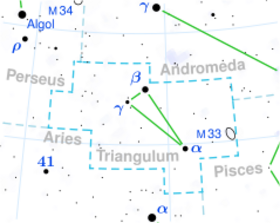Astronomy:Gamma Trianguli
| Observation data Equinox J2000.0]] (ICRS) | |
|---|---|
| Constellation | Triangulum |
| Right ascension | 02h 17m 18.86703s[1] |
| Declination | +33° 50′ 49.8950″[1] |
| Apparent magnitude (V) | +4.01[2] |
| Characteristics | |
| Spectral type | A1Vnn[3] |
| U−B color index | +0.02[2] |
| B−V color index | +0.02[2] |
| Astrometry | |
| Radial velocity (Rv) | +9.9[4] km/s |
| Proper motion (μ) | RA: 44.64[1] mas/yr Dec.: –52.57[1] mas/yr |
| Parallax (π) | 29.04 ± 0.25[1] mas |
| Distance | 112.3 ± 1.0 ly (34.4 ± 0.3 pc) |
| Absolute magnitude (MV) | +1.35[5] |
| Details | |
| Mass | 2.7[6] M☉ |
| Radius | 1.96[7] R☉ |
| Luminosity | 33.0[6] L☉ |
| Temperature | 9,440[8] K |
| Rotational velocity (v sin i) | 254[9] km/s |
| Age | 300[6] Myr |
| Other designations | |
| Database references | |
| SIMBAD | data |
Gamma Trianguli (Gamma Tri, γ Trianguli, γ Tri) is a star in the constellation Triangulum located approximately 112 light years from Earth. It has an apparent magnitude of +4.01 and forms an optical (line-of-sight) triple with Delta Trianguli and 7 Trianguli.[11]
Properties
This star has a stellar classification of A1Vnn,[3] which indicates it is an A-type main sequence star. It has 2.7[6] times the mass of the Sun and nearly double the Sun's radius.[7] Gamma Trianguli is radiating about 33[6] times the luminosity of the Sun from its outer envelope at an effective temperature of 9,440 K,[8] giving the star a white hue.[12] The star is roughly 300 million years old.[6]
Rotation
It is rotating rapidly, with a projected rotational velocity of 254 km/s along the equator,[9] which causes the star to take the pronounced shape of an oblate spheroid like Altair.[11] Because the inclination of the star's axial tilt is unknown, this means that the azimuthal equatorial velocity is at least this amount and possibly higher.[9] By comparison, the Sun is a slow rotator with an equatorial azimuthal velocity of 2 km/s.[13] The doppler shift from the rapid rotation results in very diffuse absorption lines in the star's spectrum, as indicated by the 'nn' in the classification.[14]
Debris disk
Orbiting the star is a dusty debris disk with a combined mass of about 2.9 × 10−2 times the mass of the Earth. This disk can be detected because it is being heated to a temperature of about 75 K by Gamma Trianguli and is radiating this as infrared energy. The disk is separated from the host star by an angle of 2.24 arcseconds, corresponding to a physical radius of 80 AU, or 80 times the separation of the Earth from the Sun.[7]
Naming
In Chinese, 天大將軍 (Tiān Dà Jiāng Jūn), meaning Heaven's Great General, refers to an asterism consisting of γ Trianguli, γ Andromedae, φ Persei, 51 Andromedae, 49 Andromedae, χ Andromedae, υ Andromedae, τ Andromedae, 56 Andromedae, β Trianguli, and δ Trianguli. Consequently, the Chinese name for γ Trianguli itself is 天大將軍十 (Tiān Dà Jiāng Jūn shí, English: the Tenth Star of Heaven's Great General.).[15]
References
- ↑ 1.0 1.1 1.2 1.3 1.4 van Leeuwen, Floor (November 2007), "Validation of the new Hipparcos reduction", Astronomy and Astrophysics 474 (2): 653–664, doi:10.1051/0004-6361:20078357, Bibcode: 2007A&A...474..653V Note: see VizieR catalogue I/311.
- ↑ 2.0 2.1 2.2 Johnson, H. L. et al. (1966), "UBVRIJKL photometry of the bright stars", Communications of the Lunar and Planetary Laboratory 4 (99): 99, Bibcode: 1966CoLPL...4...99J
- ↑ 3.0 3.1 Cowley, A. et al. (April 1969), "A study of the bright A stars. I. A catalogue of spectral classifications", Astronomical Journal 74: 375–406, doi:10.1086/110819, Bibcode: 1969AJ.....74..375C
- ↑ Wielen, R. et al. (1999), "Sixth Catalogue of Fundamental Stars (FK6). Part I. Basic fundamental stars with direct solutions", Veroeffentlichungen des Astronomischen Rechen-Instituts Heidelberg (Veröffentlichungen des Astronomisches Rechen-Institut Heidelberg) 35: 1, Bibcode: 1999VeARI..35....1W
- ↑ Anderson, E.; Francis, Ch. (2012), "XHIP: An extended hipparcos compilation", Astronomy Letters 38 (5): 331, doi:10.1134/S1063773712050015, Bibcode: 2012AstL...38..331A.
- ↑ 6.0 6.1 6.2 6.3 6.4 6.5 Wyatt, M. C. et al. (July 2007), "Steady State Evolution of Debris Disks around A Stars", The Astrophysical Journal 663 (1): 365–382, doi:10.1086/518404, Bibcode: 2007ApJ...663..365W
- ↑ 7.0 7.1 7.2 Rhee, Joseph H.; Song, Inseok; Zuckerman, B.; McElwain, Michael (May 2007), "Characterization of Dusty Debris Disks: The IRAS and Hipparcos Catalogs", The Astrophysical Journal 660 (2): 1556–1571, doi:10.1086/509912, Bibcode: 2007ApJ...660.1556R
- ↑ 8.0 8.1 Zorec, J. et al. (July 2009), "Fundamental parameters of B supergiants from the BCD system. I. Calibration of the (λ_1, D) parameters into Teff", Astronomy and Astrophysics 501 (1): 297–320, doi:10.1051/0004-6361/200811147, Bibcode: 2009A&A...501..297Z
- ↑ 9.0 9.1 9.2 Royer, F.; Zorec, J.; Gómez, A. E. (February 2007), "Rotational velocities of A-type stars. III. Velocity distributions", Astronomy and Astrophysics 463 (2): 671–682, doi:10.1051/0004-6361:20065224, Bibcode: 2007A&A...463..671R
- ↑ "gam Tri -- Star", SIMBAD (Centre de Données astronomiques de Strasbourg), http://simbad.u-strasbg.fr/simbad/sim-id?Ident=gam+Tri, retrieved 2011-12-11
- ↑ 11.0 11.1 Kaler, James B., "GAMMA TRI (Gamma Trianguli)", Stars (University of Illinois), http://stars.astro.illinois.edu/sow/gammatri.html, retrieved 2011-12-11
- ↑ "The Colour of Stars", Australia Telescope, Outreach and Education (Commonwealth Scientific and Industrial Research Organisation), December 21, 2004, http://outreach.atnf.csiro.au/education/senior/astrophysics/photometry_colour.html, retrieved 2012-01-16
- ↑ Stix, Michael (2004), The sun: an introduction, Astronomy and astrophysics library (2nd ed.), Springer, p. 423, ISBN 3-540-20741-4, https://books.google.com/books?id=wxHN9jP-mNMC&pg=PA423
- ↑ Kaler, James B. (2011), Stars and Their Spectra: An Introduction to the Spectral Sequence (2nd ed.), Cambridge University Press, p. 88, ISBN 978-0-521-89954-3, https://books.google.com/books?id=ZEKO2pzuRHoC&pg=PA88
- ↑ (in Chinese) AEEA (Activities of Exhibition and Education in Astronomy) 天文教育資訊網 2006 年 7 月 10 日
 |


